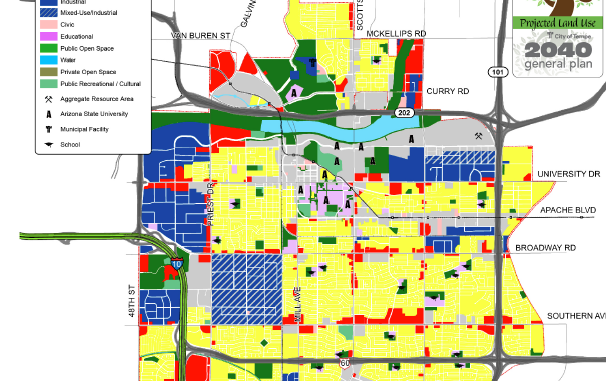
How many times have you been asked by a client “What’s going to happen over there?”, “Do you know if that is always going to be a Farm?”, “Do you know what this area will look like in 20 years?”
I have and I’m sure most, if not all of us, have been asked these or similar questions. You have a couple of sources to point your client to in order for them to answer their own questions. The City Plan and the Code of Ordinances are two sources and they can always ask the Economic Development Department since frequently the City Plan and Code of Ordinances are amended in order to accommodate current economic needs of the City.
In 2020 Cities, Towns and Counties updated their General Plans, the blueprint for their growth. This year, 2021, is the year of Zoning, Planning and Code Updates. Local governments are now in the process of updating their planning and Code of Ordinances to reflect the updated, or in some cases, completely new City Plan.
The process seems boring and in my blogpost on City General Plans and their impact on ordinances and development from last November, I discuss impacts and highlight of the changes proposed in Surprise and Tempe as examples.
Planning, zoning and codes are boring, until you realize the conversations today will directly impact the residential and commercial product available to buyers, sellers and tenants for 25-50 years in the future.
The modes of transportation available to those businesses and residents are being decided today. What property owners can do with their property and buildings will be decided based on interpretations of those new and updated City Plans.
When I ask members to fill out a survey, provide input to city staff or elected officials, or speak at a P&Z (Planning and Zoning) meeting or City Council meeting, frequently I am greeted by “but I’m not qualified” or “I don’t know anything about that”.
Nothing could be further from the truth. In fact, I would argue YOU are the most important expert in the room. Builders and Developers by the nature of their business, build product for today. That is why we sometimes see trends that suddenly overwhelm the market. Think of building mostly condos, 5,000 sf McMansions, homes on narrow lots, or HOA only products, etc. It’s not that those products aren’t needed or wanted, it is a question of how much of that specific product, in that same cookie cutter way is needed or wanted now and 40 years from now?
We all know areas in which 50 to 100 year old homes are in demand – always – no matter the market. They tend to have certain characteristics: well laid out streets, pedestrian and bike pathways, homes with good floor plans and “good bones”. Houses that met the need of buyers and renters in 1920, 1960, 2006, 2021, and will in 2045.
In commercial, it is space in an easily accessed area, with signage, that can undergo re-use as industry needs and wants change.
Last Fall Surprise was discussing narrow and small lots. As prices to build increase and demand continues to grow, the pressure on builders to build faster and still keep affordability increases. When larger houses are placed on smaller lots, the conversation naturally starts to include alleys as one tool to get more housing on a particular parcel.
The automatic response to alleys from a lot of clients is, “NO”. They visualize their new house in the future, and think about some of the alley houses in Phoenix and Tempe. Trash, dirt, weeds and unsavory behaviours happen in those neglected alleys. No one wants to deal with that in the future, and so buyers are hesitant.
Our members brought this input to the City of Surprise planners and the conversation changed from “alleys – Yes or No” to “what are the hallmarks of successful alley communities?”
What characteristics do successful alley communities have? Is it law enforcement? Is it alleys that by their siting are used every day to access out buildings or garages? Is it alleys designed to also double as play areas, bike or bridle paths, or some other recreation asset?
How wide should an alley be? Should it be wide enough for a landscape truck and trailer to use? Should it be wide enough for a luxury RV to get in and out of its parking location?
The conversation that results is one on which use of the alley helps determine size of the alley. The general consensus seems to be the big deterrent to crime, trash and weeds in alleys is regular use.
That is a conversation WeSERV members are very well suited to. You hear your buyer’s and sellers’ comments and you know their concerns. Your input isn’t just representative of you, it is representative of your clients and their desires and concerns for the next several decades.
WeSERV members by the nature of their businesses, look at not only the wants and needs of today, but the probable wants and needs of the market in 50 years…because WeSERV members sell and lease product built over the decades.
So, the next time you are asked to fill out a WeSERV GAD survey, provide input to a local government or present at a City Council meeting, think about the valuable viewpoints you represent. Let the city officials know what you know.
WeSERV GAD: Advocating for private property rights, the right to private contract and YOUR business!
